
Thinking processes for experience
design strategy and deployment
During the 1990-early 2000s, I spent time working with the Disney Imagineers and Park Strategists at Disneyland — designing experiences, brands and their integrated strategies in Orlando and Anaheim. As well, during that time, we worked with Steve and Elaine Wynn on Bellagio and their teams and properties. All sides, I learned a lot about design thinking — the planning of holistic renderings of journey, queue, storytelling, graphical elements — and how it all fits together.
When you consider it, sensational design — designing for the senses — restaurants are the best platform for complex, integrated holistic engagement.
These studies range from intimate and close-in, managed entertainment affairs and queue-based experiences, to guest enchantment at sit-down as well as wandering explorers of varied food experience options.
Many times in my career, I was drawn into realms of brand work and design, that I was curious about, but didn’t have much experience. I wandered in.
B R A N D D R I V E
What that range of design learning taught me — specific to dining offerings in design, strategy and procession, is that a restaurant visionary will need to have a clear visioning about the core distinction of the proposition of value and exchange — coupled in the passion of what drives that person, the restaurant’s leadership and their teams. Leadership will be about participation and involvement. That’s a key — who is there, managing the team, who inspires, who fires the drive of the brand?
WHAT ABOUT YOU?
What are your key offers answering the question as to why a person would like to be there — this place that you are making? Simple question — it’s the why.
Why should we do this?
What difference are we offering?
More seats? Special foods? Preparations? Environment? Spectacle?
Everything comes back to
intention, which drives attention and attraction.
People are enticed to an offering —
they come, they explore, they savor, they stay, they go.
We call it
the E’s:
They are
enchanted —
the song, the chant, of the offering is a compelling expression, magnetism happens.
The drawing nigh begins.
There is
engagement.
After a sense of magnetism and vibrational attraction
[“I like the vibe of this place, feels good, I get it…”]
There is commitment — the story will be shared.
There is
embracement.
There is the offer of a gift and there is a recipient of that gift. And a price might be paid for that exchange.
The equation comes to:
what is your intention?
And what is your gift?
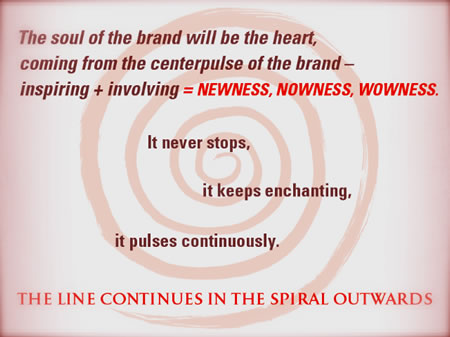
We think of journeys as pathways and labyrinths —
which is a sequencing, a spiral of brand experience design:
GIRVIN’s red thread of connective analyses —
that is, if you’re thinking about creating a restaurant or any type of brand experience offering, think deep first.
Then plan
and build. All builds start with a dream. They must have that foundational mysticism: the dream, the idea[l], the vision and out there — the actualization.
Working for years on the propositions of food experience — from luxury dining to kiosk service, fast casual to white tablecloth, we have a legacy of searching for the engagement tools for guests, building in a certain set of experiential devices in analyzing the success of brand storytelling and experiencer relationships in dining design.
What kind of restaurant could you be?
You could start simple, faster, more accelerated service: fast casual, as noted below —this journeying and watch-fullness sets the foundation for consideration of your ideal.
Or, go complex.
Or go towards some other admixture.
But go deep,
to passion,
your deepest commitment,
the drive.
If you’re creating a restaurant, you’ll need to clarify and respond to this question: are you building a proposition of something quick and accessible, or a more complex table service?
Let’s start with one, the notion of a speedier brand storytelling. There’s a distinction, between the conceptions of fast casual [FCR] and QSR — quick serve restauarants. And the processing purports formulae to dollars spent, interior character and brand environment.
Go fast: foundational rules
of the dining experience strategy —
QSR, fast casual,
or upscale potential environments
The basic rules of the road apply across the field of experience planning
• Food will be, and always shall be: everything. Without great food, the restaurant will be building an audience of unstable relationships. The community won’t be connected. No high-flying design will save a restaurant without great product. Money aside, the relationship to customers will be superficial and weak.
• Sequences of action.
The real procession — far-out to close-in, walk-in: being served, leaving happy — this is fundamental, but oftentimes ignored. How does that work — how would you manage the journey of *experientiality?
• The core standards
of the connection between the team and guest is another proposition. How was that sequence managed — what’s the greeting, what’s the differentiation,
what is, where is, the sincerity?
• Care — who cares, really?
The idea of care is a permeation that needs to stretch everywhere in the experience planning —
but how is it managed?
• The sense of place —
so much of fast casual (which might be anything from a Starbucks to Chipotle, relates to pricing and time — budgeting per serve are roughly $7.50 — 11.00. The items can be less, but the potential strives for multiple turns in the day’s meal cycles.
How might this be analyzed?
Sequentially.
In our expertise, the idea of sorting process and epiphanic moments could be synchronized to a step-by-stride, instant-to-instance, moment-to-momentum:
the dance of the practice.
And practice — it is — makes perfect.
In analyzing literally dozens of fast casual experiences, there are learnings:
• Brand is crucial —
it’s obvious what this place is.
Considered and comprehensive?
You stand for something,
there is a badge that says who you are.
• Story is comprehensible —
tell the consumer, fast,
what the story is.
Don’t make them work for it —
find ways to tell it, signing
and graphics, menus and mobile,
websites and print offerings.
• Process is fluent —
the guest can get into the place,
through the server line and
orders shall be resolved efficiently.
Served up.
• If they can stay, how long? —
timing the sequence,
for stay,
for work,
the third place,
respite,
meal and out,
drink and connect.
Has this been designed?
• The market, the community of your audiences —
knowing your market,
the competition thoroughly,
who’s winning and how they are evolving —
good inquiry to examine.
Asking this question — are you up to speed
with who’s out there?
D E F I N I N G I N Q U I R Y | S E T T I N G
T H E H I G H E R I D E A L
We define: establishing Brand benchmarks
will establish consistency and clarity,
which is important in times of growth,
when money is being spent and decisions are crucial.
A consistent Brand,
coupled with individual location distinction,
appears stronger to consumers and investors,
ensuring confidence to buy.
EXTENSIBILITY
THE BRAND FOUNDATION:
WORKING SYSTEMS
CORPORATE BUSINESS PAPERS
Standardized system for all corporate documents including: business card, letterhead, #10 envelope, large size envelope, mailing label and forms such as invoices and Word templates for letterhead. Building digital forms for email is another cohesion to brand lineage.
WHAT’S IN FRONT
SHOULD BE CONSISTENT:
BACK OF HOUSE COLLATERAL
Employee schedule, employment applications, inventory, morale boosting and messaging as well as other applicable forms — upfront one way, same on the back side.
BRINGING A HOLISTIC MESSAGE:
MEDIA KIT*
Brochure, delivery system, designed one-sheets.
The sensation of passion and wholeness are clear, what you stand for, what you’re like, what you mean — these are the resonant element of memorability.
LINKING CONTENT AND TRAINING TOOLS:
EMPLOYEE TRAINING MATERIALS*
New trainee folder, unique welcome gift, “For a Friend” coupon. Designed one-sheets w/ training information. Brochures and overview.
*Could be combined into one kit.
INTEGRATION OF STYLISTIC INTENT:
BRAND STYLE GUIDE
The Brand style guide is a manual for creative and marketing professionals, including vendors, for optimal consistency across a variety of applications. This guide includes configuration and exact specifications for use of the Brand Identity, including “do’s and don’t’s”; use of color and specifications;
type hierarchy and layout guidelines; guidelines for additional elements such as graphic and photographic styles. An expected deliverable is a reference manual in book and digital form.
OWNING THE LOOK:
ILLUSTRATION STYLE
An expected scope of strategy should include analyzing current and previous illustration styles and defining a consistent style that is most suitable to the Brand, reasonably moderate in budgeting and adaptable to various illustrators.
UNDERSTANDING THE MINDSET:
THE REASONING FOR INVOLVEMENT
A few of the core reasons why a person goes out to eat:
Hungry
(for new or reliably predictable experiences).
There is
nothing to eat
in the house
(speed and convenience).
It’s routine
(the habitual relationship).
Going with others
(an ongoing interaction).
Meeting others — a place
(the nexus).
THE RUDIMENTS OF ANALYSES |
HOW TO PLAN
It’s important to bear in mind that the process for sequencing brand experience is one of complex detailing — these graphical discussions merely pinpoint the opening arcs of each phase of development — how you think about it, how you’re telling your story.
There are myriad points of connection to a community relationship and they’re not only inside the walls of the enterprise, but to the employees and their families, and the importance of the surrounding community.
–––––––––––––––––––––––––––––––––
A PRELIMINARY
STRATEGIC OVERVIEW
Creating a cartography or mapping of restaurant experiences — the complexity of engagements is a good foundational checklist — designing this as a kind of gathering of all the possibilities of encounters, perceptions and points of brand management builds the basic layer for how to see what potentials there could be in any study, for any type of restaurant. For this grid, our fast casual circling — the red thread of brand embracement — the centerpoint of the symbolic allegory is a “burger” icon (for the basic offering of one client relationship that used this methodology.)
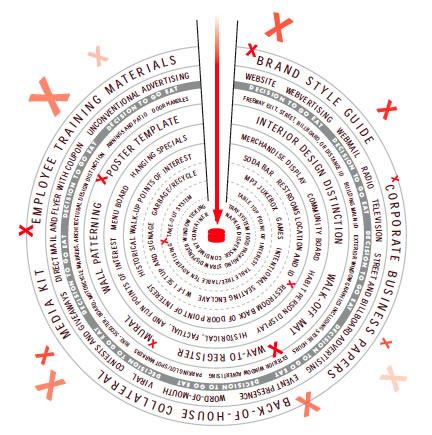
STAGGERING THE EXPERIENCE TOUCHPOINTS |
THE RHYTHM OF SPECTACLE
The process of connecting, or disconnecting, with guests is made on many layers of contact — break one and you might break them all. One grand experience can be quickly dispelled in a break of the happy sequence of attractive actions. It’s always that challenge, sequencing discovery and attention must be paid to the intention
of the brand and its offering.
Think like a guest.
What happens?

THE EQUATION OF GOODNESS |
AN ENLARGED PHILOSOPHY
We’ve explored the idea of goodness — this reaches to the notion of good experiences — but as well the value of the guest relationship and finally how that equates to the community — doing right,
doing good is a one-on-one experience,
as well as one —
your brand —
to community.
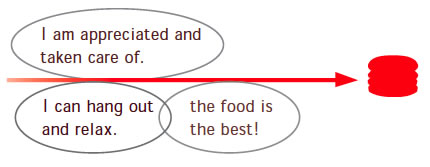
How does your guest
own their place —
at your place?
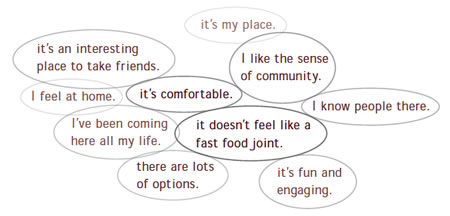
X MARKS THE TOUCHPOINT |
CLUSTERING SENSATE STORYTELLING MOMENTS
In this sequence of images, the idea of the touchpoint is something that is defined as the x – marking the spot of the sequence of connections in procession — the literal process for how guests encounter the presence of your brand. Brand presence, to our thinking, relates to “being present,” awakened and alive — vitally “on.”
In all ways: on.

THE PROCESS OF ENGAGEMENT |
THE PLEDGE OF COMMITMENT
Engagement, embracement, envelopment
in the brand experience
is something that isn’t just inside the doors — it can begin blocks away as messaging potentials present themselves. And the etymological reference to “engage” is literally to pledge. And to that reference — what is your promise, your pledge?
Each one of these “ripples in the ring” should be considered — point: signing, point: drivethrough, point: standard, point: your front door, entry, point: merchandising, menu and window messaging and offering visualizations. All synchronous — casually observed by the guest in transition, but powerful in its holistic mechanism.
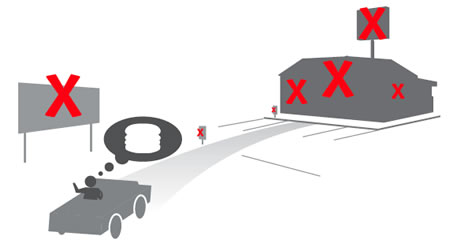
THE ENTRY SEQUENCING |
THE JOURNEY BEGINS
The entry is the beginnings of the close encounter, team members come into proximity, small messaging begins to build, as well as enlarged layers of storytelling. Everything that the brand does is about telling a story — greater, or smaller, a detail in the movement of the guest into the closest proximal relationship to brand place. Everything is a story — and the question relates: “what’s your story — and how will you be telling it?”
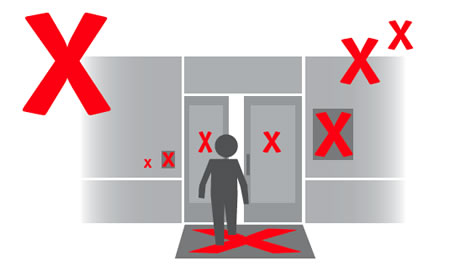
THE INTERNAL PROCESSION |
NAVIGATION
Lines happen — volume suggests action, so the play of the line and parlaying that as a decision-making process will be important. But will this sequencing might be only about storytelling the product, or building the layering of the brand experience — in that storytelling. While classic fast casual strategy mostly suggests raw product portrayal, there are other potentials — history, heritage imagery, ideals and attributes, community involvement, vendors and relationships — the scene could be rife with additives. Build strategically, that sequence — think Disney, Universal Studios or other entertainments. Small, or large, the messaging can count — especially if people are waiting. Tell your story, show the betterment of what they came for, enticement shall magnetize.
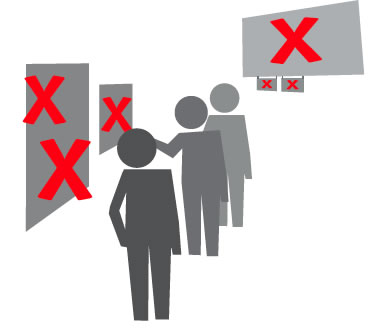
THE COUNTER ENCOUNTER |
LESSONS LEARNED
The propositions of face-to-face connectivity are priceless — and they can account for the win, or the lose, of the entire relationship. Anyone who’s ever had an expert experience in a restaurant, inside or out, employee or guest will know this intimately. If this could be won — and practiced happily — everyone succeeds. But that’s only part (and a very significant part) of the engagement — more messaging ensues and the dramatic, powerfully accessible, comprehensibly appetizing this process is, the better. In our experience, the notion of dramatic photography isn’t the only measure of success — fast clarity, careful messaging and explanation
are just as vital.
Be social.
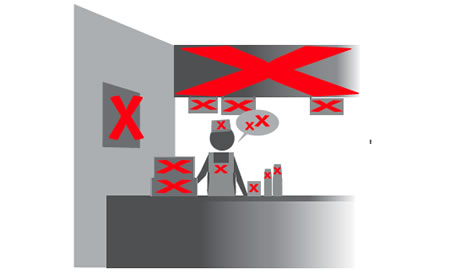
INTERNAL CIRCULATION |
WHAT PROOF CAN BE FOUND?
Up and about, guests circulate — what is the expanse of the brand storytelling? The landscape should support a sense of the authenticity of the statement; it’s not a hollow premise. Experience counts just before, and just after the meal — exploring the place, there can be added layers of messaging to build on the depth of the story. People will read-in if you purport dimensionality of brand storytelling and layering of expressions to the truth of your potentiality. It’s not the same old — it’s a song with different melodies — catching the drift of the tune builds expansiveness of experience detailing.

THE SENSE OF THE TABLE |
THE CARTOGRAPHY OF ARRANGEMENT
A sight for hungry eyes — food, packaged, branded messaging, storytelling on the wrap, table amendments — amenities can offer the touch of another point of experience envelopment. That point — the “containment” is the same as embracement — the guest is enveloped in the meal, the taste, scent, sight, touch, sound of that prize — it’s why they are fundamentally here.
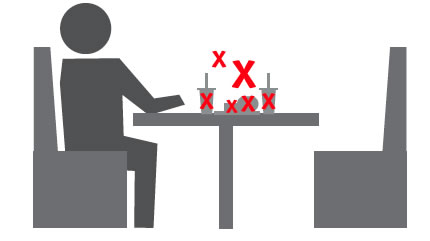
ANALYZING THE GATHERING OF POTENTIALS |
THE BALANCE
As noted in the beginnings, the positives and negatives of the experience can be shining wonders to grand times — any moment, potentially disarmed by a wayward, brand “off” encounter. It all adds up, or down — it’s up to the management of the brand to make it sing.

THE CLOSURE |
THE SEND OFF
What’s the good bye?
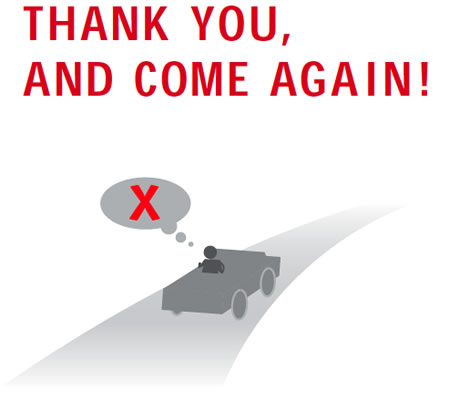
THE SOUL OF PLACE |
BRANDS AND EXPERIENCES BUILT BY HUMANS
In the opening imagery, we offered the notion of the red thread of experience layering; but any brand will start with the soul of its foundation — the people that are inspired to make the offering — that could be the visioning of the founder, or it could be a team-envisioned dream. But the soulful nature of any proposition shall speak to the potency of nurturing the cult and enculturation of those values. There needs to be a tenet of intention, which builds attention and catalyzes attraction.
People are people; they make things.
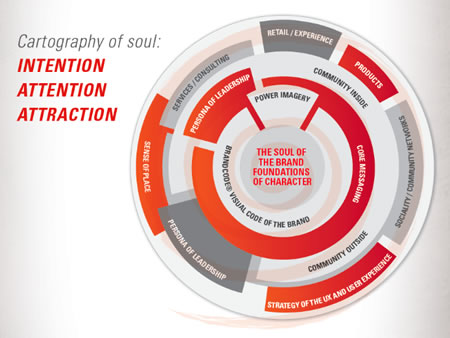
Tim Girvin | Drafted at Harbor, Schaumberg, Illinois
Project Context:
http://goo.gl/0i0Hj8
*Experientiality — design thinking founded on a multi-sensory strategy of experience development: integrated holism.